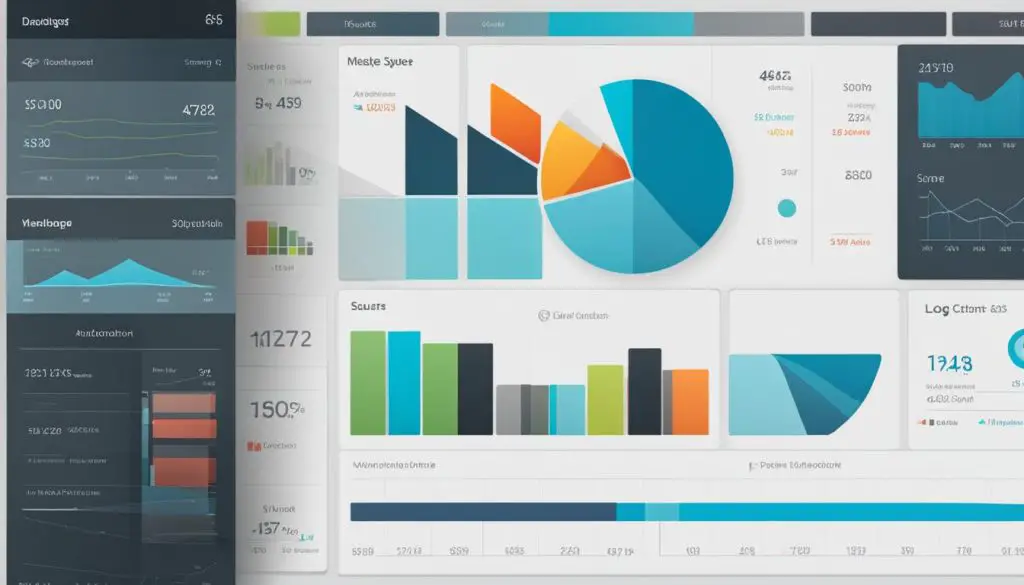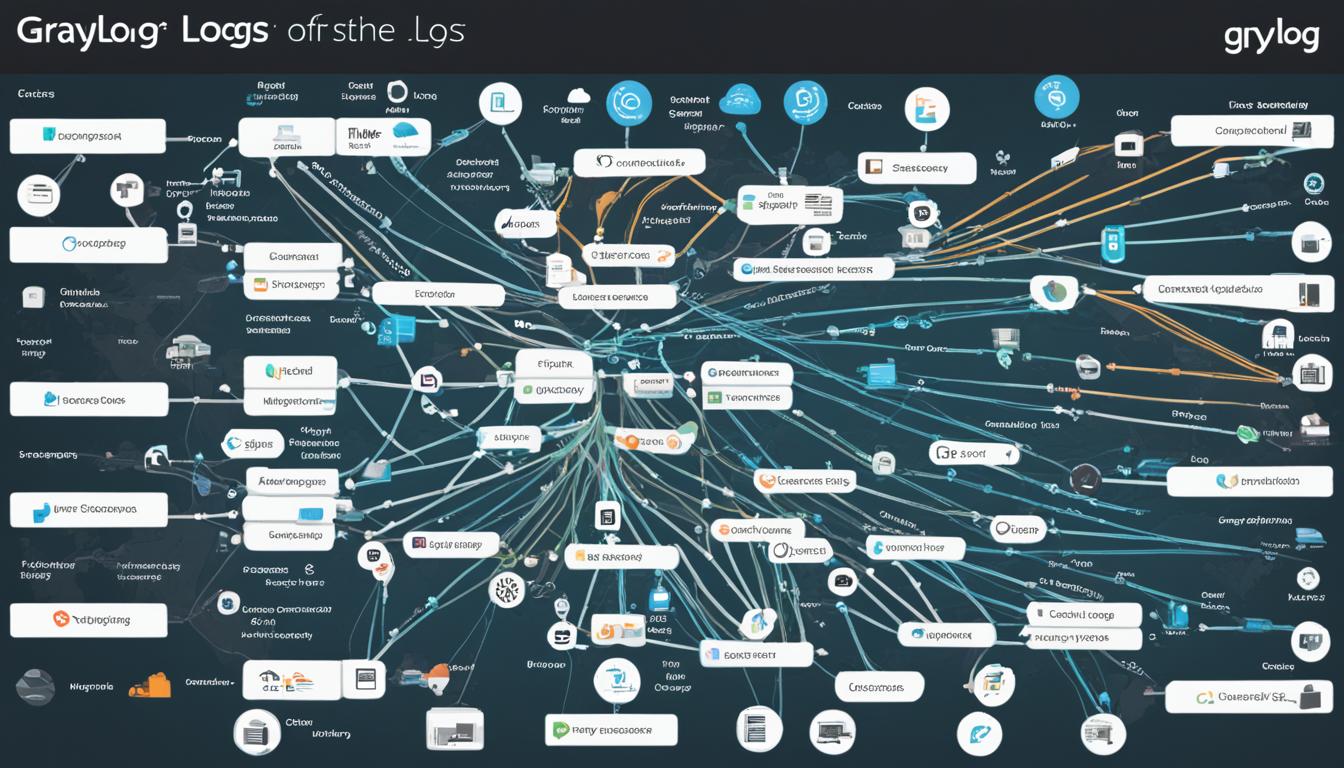What is Graylog: Your Intro to Log Management
Are you struggling to manage and analyze the logs of your systems? Are you looking for a powerful tool that simplifies log collection, storage, analysis, and visualization? Look no further, because Graylog has got you covered.
Graylog is an open-source log management and analysis tool that offers a wide range of features and benefits. From centralized log collection to efficient log search and analysis, Graylog helps you troubleshoot, monitor, and improve system performance effectively.
In this article, I will delve into the key features and benefits of Graylog, explore its architecture, and provide best practices for using it. Get ready to revolutionize your log management workflow with Graylog!
Key Takeaways:
- Graylog is a powerful open-source log management and analysis tool.
- It offers centralized log collection, storage, analysis, and visualization.
- Graylog simplifies troubleshooting, monitoring, and improving system performance.
- Understanding Graylog’s architecture and best practices is crucial for effective log management.
- Stay tuned to discover the benefits and capabilities of Graylog!
Understanding Logs and Log Management
Logs are automatically generated data that document activities in systems, networks, and applications. They can be in various formats such as .log, .txt, JSON, or CSV. The creation of logs is an essential aspect of monitoring and maintaining the security and performance of these systems. They serve as a record of events, errors, warnings, and other important information that occur within the infrastructure.
Log management involves the process of generating, transmitting, storing, analyzing, and disposing of logs. It is a critical practice for organizations as it allows them to effectively monitor and troubleshoot their systems, ensure compliance with various regulations such as FISMA, HIPAA, SOX, GLBA, PCI DSS, and GDPR, and improve overall security.
One common approach to log management is centralized log management, which enables organizations to handle logs from various sources in a unified manner. This approach offers several benefits, including:
- Improved security: Centralized log management provides a consolidated view of log data, facilitating the detection and investigation of security incidents. It enables organizations to identify patterns, anomalies, and potential threats in real-time.
- Troubleshooting capabilities: By storing logs in a central location, organizations can easily search and analyze them when issues arise. This enables faster troubleshooting and issue resolution, minimizing downtime and improving system performance.
- Compliance documentation: Centralized log management ensures that organizations can meet their compliance requirements by providing a centralized repository of log data. This facilitates auditing and reporting processes, making it easier to demonstrate compliance with regulatory standards.
By implementing effective log management practices, organizations can harness the power of log data to enhance their operational efficiency, security, and compliance.
The Benefits of Centralized Log Management
Centralized log management is a powerful solution that brings numerous benefits to organizations. By implementing a centralized log management system, businesses can optimize their log collection, storage, analysis, and retention processes, leading to improved system performance, enhanced security, and streamlined troubleshooting. Let’s explore the key advantages of centralized log management in more detail:
Efficient Log Collection
Centralized log management simplifies the process of collecting logs from various sources. Instead of manually monitoring each system or application, log collection tools automatically gather log data from different devices and consolidate it in a central repository. This ensures that logs are not missed or overlooked, enabling organizations to have a comprehensive view of their system activities.
Improved Log Storage and Retention
Effective log storage and retention are crucial for compliance, troubleshooting, and historical analysis purposes. Centralized log management systems provide scalable and resilient storage solutions that can handle large volumes of log data. With efficient log storage and retention capabilities, organizations can easily access and retrieve logs when needed, ensuring compliance with industry regulations and facilitating effective investigation and analysis of security incidents.
Streamlined Log Analysis
Having log data in a centralized location simplifies the process of analyzing and extracting insights from logs. Centralized log management systems offer powerful search and filtering functionalities, allowing users to query logs based on specific time ranges, keywords, filters, or custom parameters. This enables faster identification of issues, performance bottlenecks, and security incidents, leading to quicker troubleshooting and issue resolution.
Enhanced Security and Compliance
Centralized log management plays a vital role in enhancing security and maintaining compliance with industry or regulatory standards. By aggregating logs from multiple sources, security teams can identify and correlate events across systems and applications to detect suspicious activities and potential threats. It also ensures that every log is collected and retained, meeting compliance requirements such as data retention policies, audit trails, and incident reporting.
Customized Dashboards and Reports
Centralized log management systems often offer the ability to create customized dashboards and reports. These dashboards provide visual representations of log data, enabling users to monitor system health, track key metrics, and identify trends or anomalies. Customizable reports help organizations generate insights and meet reporting requirements, facilitating informed decision-making and resource allocation.
In conclusion, centralized log management brings significant advantages to organizations by enabling efficient log collection, improved log storage and retention, streamlined log analysis, enhanced security and compliance, and the creation of customized dashboards and reports. By implementing a centralized log management solution, businesses can optimize their log management workflow, improve system performance, and bolster their security posture.
Graylog Architecture Overview
Graylog’s architecture is composed of different components that work together to provide efficient log management and analysis. Understanding the underlying architecture of Graylog is essential for effectively utilizing its features and maximizing its benefits.
At the core of Graylog’s architecture are the Graylog servers. These servers are responsible for receiving log data from various sources and managing its storage and retrieval. They act as the central hub for log management activities.
Elasticsearch, a distributed search and analytics engine, plays a vital role in Graylog’s architecture. It is used for storing and indexing the log data, enabling fast and efficient searches and analysis. Elasticsearch ensures that log data is readily available for real-time monitoring and troubleshooting.
MongoDB, a popular NoSQL database, is utilized by Graylog for storing configuration data. This includes information about alert rules, user accounts, and other administrative settings. By leveraging MongoDB, Graylog can efficiently manage and access the necessary configuration details.
The web interfaces of Graylog provide users with a user-friendly platform to interact with the log data. These interfaces enable users to perform searches, analysis, and visualizations, allowing for comprehensive log exploration and monitoring.
Overall, the architecture of Graylog incorporates the Graylog servers, Elasticsearch, MongoDB, and web interfaces to create a seamless and powerful log management solution. By utilizing this architecture, Graylog empowers users to efficiently store, search, analyze, and visualize log data, enabling effective troubleshooting, monitoring, and system optimization.
Graylog Integration – GELF
In addition to its robust log management and analysis capabilities, Graylog offers seamless integration with various programming languages and logging frameworks through GELF (Graylog Extended Log Format). This integration enables developers to easily implement the sending of log messages to Graylog via UDP, simplifying the process and ensuring data reliability.
GELF serves as a standardized log format that can be utilized across different platforms and environments, making it easier to aggregate and analyze log data within Graylog. By leveraging GELF integration, developers can streamline their logging operations and gain valuable insights into system performance, troubleshoot issues more effectively, and enhance overall log management.
Whether you are developing applications in Python, Java, Ruby, or any other programming language, Graylog’s GELF integration provides a seamless pathway for sending your log messages directly to Graylog for analysis and visualization.
Why Choose GELF Integration with Graylog?
There are several significant advantages to utilizing GELF integration with Graylog:
- Simplified implementation: GELF offers an easy-to-use format for sending log messages, reducing the complexity of implementing log forwarding to Graylog.
- Reliable log transmission: GELF uses User Datagram Protocol (UDP) for log transmission, ensuring that log messages reach Graylog reliably.
- Cross-platform compatibility: GELF can be integrated seamlessly with various programming languages and logging frameworks, making it accessible to developers across different environments.
- Efficient log aggregation: By leveraging GELF, developers can aggregate log data from multiple sources into a centralized location, providing a holistic view of their systems.
- Streamlined log analysis: GELF integration with Graylog enables developers to perform in-depth log analysis, allowing for efficient troubleshooting, performance monitoring, and proactive system maintenance.
With its GELF integration, Graylog empowers developers to enhance their log management workflow by seamlessly integrating log messages from different programming languages and frameworks, facilitating efficient log analysis and ensuring data reliability.
Searching and Analyzing Logs with Graylog
Graylog offers users a user-friendly web interface that enables efficient search and analysis of log messages. With Graylog, you can easily retrieve specific log data using various parameters such as time ranges, keywords, and filters. By inputting your desired search criteria, Graylog allows you to quickly access the relevant log messages to facilitate troubleshooting and monitoring of system performance.
Graylog’s advanced search capabilities enable you to refine your log search to specific timeframes, making it easier to identify the root cause of any issues. Additionally, the solution provides tools for field statistics, aggregation, highlighting, annotations, and exporting results. These functionalities further enhance your ability to analyze log data and extract valuable insights.
“Graylog’s powerful log search functionality allows users to easily navigate through the vast amount of log data, helping them to uncover trends and patterns that may otherwise go unnoticed.”
By leveraging Graylog’s search and analysis capabilities, users can pinpoint critical information from their log data, aiding in the identification of system vulnerabilities, identifying security incidents, or uncovering performance bottlenecks. Furthermore, Graylog’s ability to export results facilitates collaboration and sharing of log data with stakeholders or for further analysis.
Being able to efficiently search and analyze logs plays a crucial role in ensuring the security, stability, and performance of your systems. Graylog simplifies this process through its intuitive web interface, making it an essential tool for log management and analysis.
Creating Dashboards in Graylog
Dashboards in Graylog empower users to design customized visual representations of log data, enhancing the monitoring and analysis capabilities. With Graylog’s intuitive interface, users can select from various layouts and add widgets such as charts and tables, enabling them to showcase the most relevant log data in a visually appealing manner.
Graylog’s dashboard creation process is simple and flexible. Users have the freedom to configure each widget according to their specific needs, ensuring that they display the most pertinent log data. Whether it’s highlighting key performance indicators or tracking important metrics, Graylog’s dashboards provide a consolidated view that enables users to monitor system health and performance effectively.
By utilizing Graylog’s dashboard functionality, users can gain valuable insights into their log data at a glance. The visual nature of dashboards facilitates the identification of trends, anomalies, and patterns, allowing for proactive monitoring and efficient troubleshooting. Whether it’s monitoring application performance, tracking security incidents, or analyzing system logs, Graylog’s dashboards provide an invaluable tool for log management.

Best Practices for Using Graylog
When it comes to utilizing Graylog effectively, implementing a few best practices can greatly optimize your log management workflow. Let’s explore some key recommendations to maximize the performance and efficiency of Graylog.
1. Configure Log Collection Settings
One of the first steps in using Graylog is configuring log collection settings. Take the time to determine the relevant log data that you want to collect and analyze. This will help you focus on the most critical information, avoiding unnecessary data clutter. Consider whether a minimalist or maximalist log collection strategy aligns best with your specific requirements. Additionally, keep in mind the long-term log storage and retention needs of your organization.
2. Set Up Log Rotation
Log rotation is an essential practice to ensure efficient log management. Define a log rotation schedule based on the size, type, and importance of your log files. By regularly rotating logs and compressing older files, you can free up storage space and ensure optimal performance.
3. Optimize Log Aggregation
Efficient log aggregation is crucial for analyzing log data effectively. Consider configuring log aggregation settings based on your specific use cases and requirements. By aggregating logs based on similar attributes or patterns, you can streamline log analysis and gain valuable insights into system behavior and performance.
4. Focus on Log Parsing and Normalization
Proper log parsing and normalization are key to extracting meaningful information from your log data. Configure parsing rules to transform raw log messages into standardized formats that can be easily analyzed and understood. By normalizing log entries, you can ensure consistency and simplify the process of correlating events during root cause analysis.
5. Utilize Correlation of Events
Correlating events across different log sources can provide valuable information for identifying and resolving issues. Graylog allows you to create correlation rules that help you link related log entries and uncover dependencies and patterns. By analyzing correlated events, you can gain deeper insights into the root causes of problems and optimize your troubleshooting process.
6. Adopt Best Practices for Log Analysis, Security Monitoring, and Compliance
Make use of Graylog’s comprehensive log analysis capabilities to extract valuable insights from your log data. Leverage features such as field statistics, aggregation, and highlighting to identify trends and anomalies. Implement robust security monitoring practices by setting up alerts and notifications to detect potential security incidents. Ensure compliance with regulatory requirements by configuring logs retention policies and generating compliance reports.
7. Create Customized Dashboards
Take advantage of Graylog’s dashboard functionality to create personalized visual representations of your log data. By designing customized dashboards, you can track important metrics, monitor system health, and gain a holistic view of the performance and security of your environment. Experiment with various widgets such as charts, tables, and graphs to create informative and visually appealing presentations of your log data.
By following these best practices, you can harness the power of Graylog for efficient log management and analysis. Configuring log collection settings, implementing log rotation and aggregation, focusing on log parsing and normalization, utilizing correlation of events, and adopting best practices for log analysis, security monitoring, compliance, and dashboard creation will help you unlock the full potential of Graylog.
Conclusion
In conclusion, Graylog is a powerful open-source log management and analysis tool that provides organizations with centralized log collection, storage, analysis, and visualization capabilities. It simplifies the process of managing logs from various sources, improving troubleshooting and issue resolution. With Graylog, organizations can enhance security and compliance by efficiently monitoring log data and generating valuable insights.
By leveraging Graylog’s features and following best practices, organizations can ensure system reliability and optimize their log management workflow. Graylog’s customizable dashboards enable users to create visually appealing representations of log data, making it easier to monitor system health and performance effectively. Furthermore, Graylog’s integration with various programming languages and logging frameworks through GELF simplifies the process of sending log messages, ensuring data reliability.
Overall, Graylog is a comprehensive log management solution that empowers organizations with enhanced log analysis and monitoring capabilities. By utilizing Graylog’s centralized log collection, efficient log storage, and advanced log analysis features, organizations can streamline their log management processes, improve system performance, and enhance overall security and compliance.
FAQ
What is Graylog?
How does Graylog simplify log management?
What are the benefits of centralized log management?
What is the architecture of Graylog?
How does Graylog integrate with other systems?
How can I search and analyze logs with Graylog?
Can I create customized dashboards in Graylog?
What are some best practices for using Graylog?
Source Links
- https://graylog.org/post/what-is-log-management-a-complete-logging-guide/
- https://graylog.org/
- https://medium.com/@ozerturk/centralized-log-management-with-graylog-4101497c9420
- About the Author
- Latest Posts
Mark is a senior content editor at Text-Center.com and has more than 20 years of experience with linux and windows operating systems. He also writes for Biteno.com






